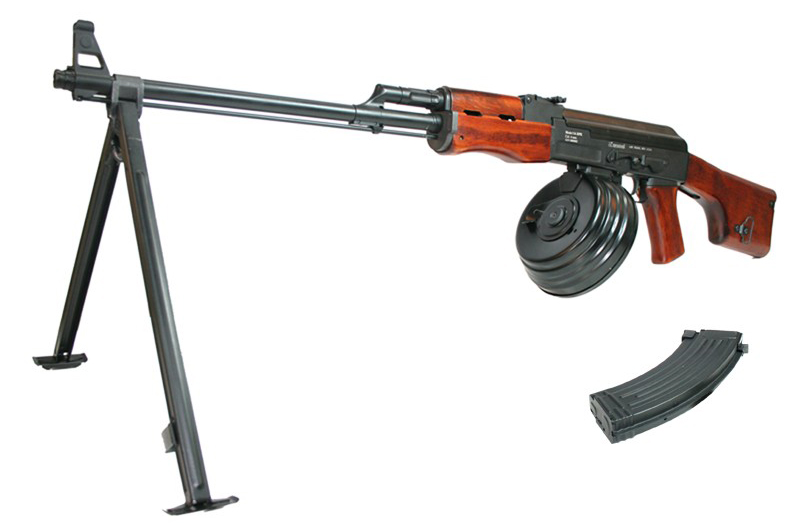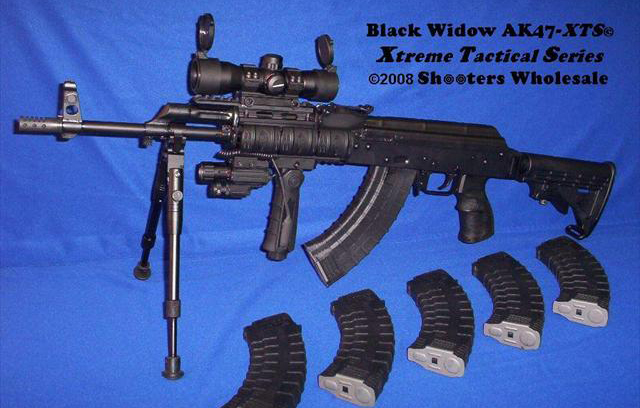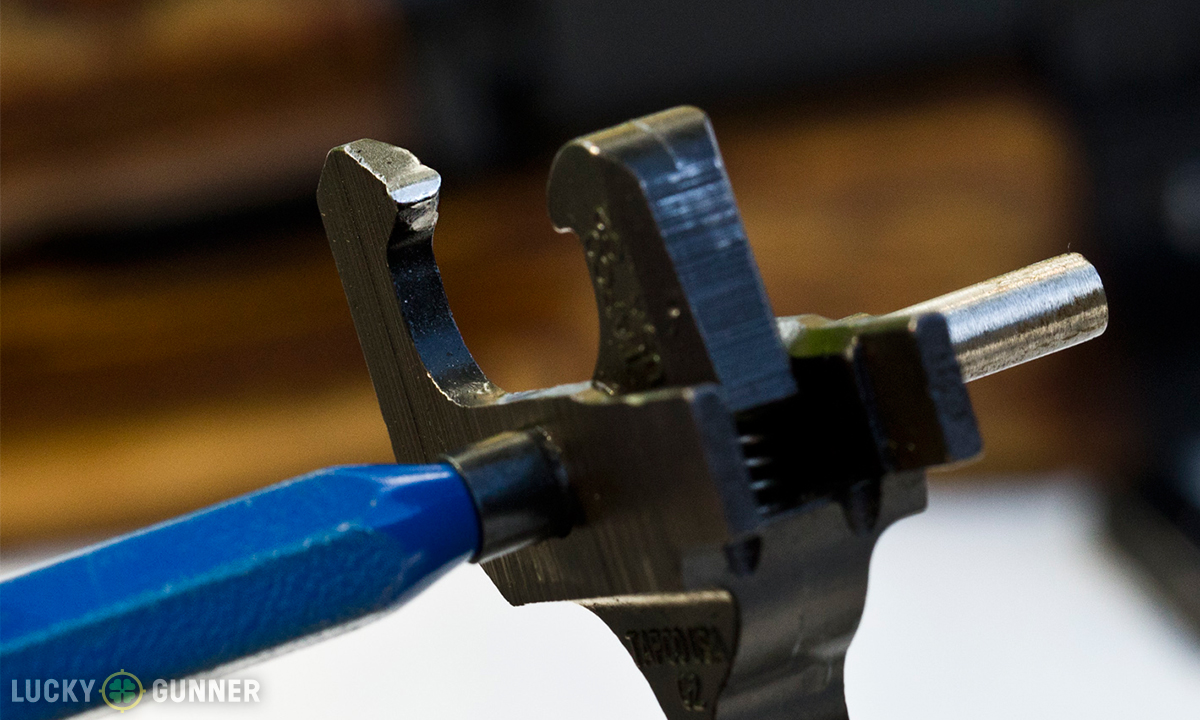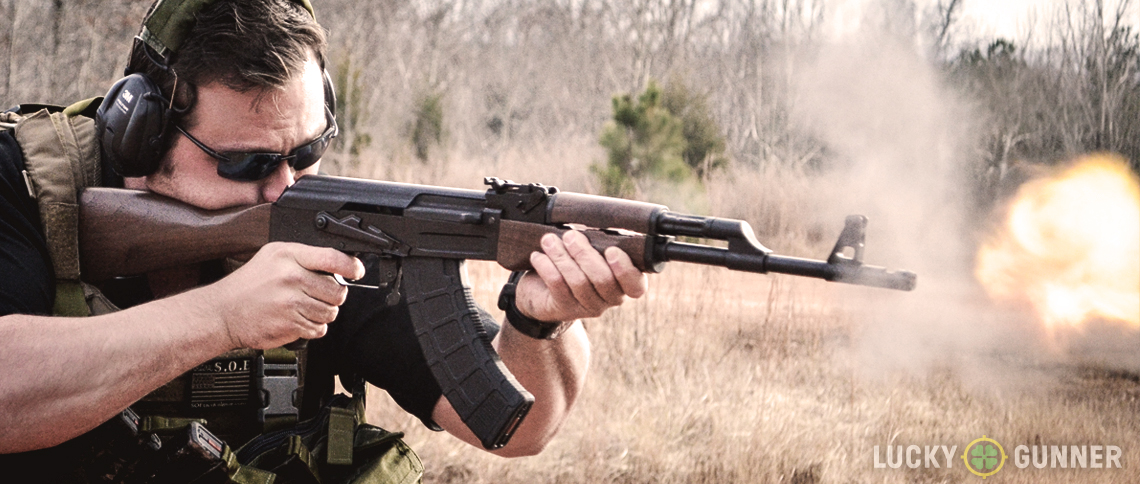One out of five firearms in the world is an AK of some kind. Books have been written about what a great rifle it is, and they are right. If you live in a free state that allows you to keep and bear one, you should. I’ve been shooting them, professionally building and modifying them, fixing them, and just appreciating them for about fifteen years now.
Whether you have an AK now, or you’re looking to add one to your gun rack, there are a few common AK mistakes and pitfalls that you should be aware of. They are easy enough to avoid, and you’ll save some money and annoyance if you keep them in mind.
1. Attaching a bipod to the end of the barrel
The RPK light machine gun is one of the coolest looking AK variants out there. Its long 23 inch barrel looks beefy and snipery (snipery is a word, right?), and oftentimes shooters purchase an RPK type hoping for increased velocity due to the barrel length (absolutely true) and increased accuracy as well (absolutely false).

Under the best of circumstances, the RPK is no more accurate than a standard AKM. Sorry, it just isn’t. When you put the RPK on its big bipod, which mounts to the very end of the muzzle, the bipod holds the muzzle still and the barrel basically sags in a banana shape, imperceptibly to the naked eye.
Shooting from a deployed bipod can result in a point of impact roughly four inches higher at 100 yards than shooting the same gun from sandbags. Shoot fast enough to get the barrel hot and the rounds start to “walk” even higher. Increase the range and the disparity grows.
If you have an RPK, decide whether you want to shoot it exclusively from the bipod or exclusively without the bipod deployed, and sight it in accordingly. Be ready to compensate for vertical stringing as the barrel heats up. Or, you know, you could just rapid fire and walk your rounds onto that milk jug after you see where the first couple of shots landed. Nobody has to know.
In combat, the RPK gunners have used a lot of tracer rounds to improve their aiming abilities as barrel temperatures and engagement ranges vary during the firefight. Putting a bipod on the end of a standard AK barrel invites the same exact problems, but to a lesser extent due to the decrease in barrel length. My advice on putting a bipod on your AK? Don’t!
2. Poorly placed forward pistol grips
There have been a lot of AK variants with forward pistol grips, and most of them suffer from the same problem: they interfere with the “rock in” magazine design. The AK requires the user to tilt the bottom of the magazine forward to insert the front tab into the mag well notch, before snapping the magazine body rearwards to lock the rear tab into the mag catch. It’s actually a very strong and robust system, although not the fastest to reload.

Fast reloading is made exponentially harder if your magazine, or the hand holding it, runs into a forward pistol grip hanging right where the magazine arcs. It doesn’t make mag changes impossible, it just makes them more problematic, and mag changes are an area where the AK already lags behind compared to other systems like the AR-15.
For this reason, I think the Magpul AFG or a small hand-stop setup is a natural choice for the AK if you decide to put some sort of grip enhancing device on the forend. Keep forward pistol grips short and mounted forward on your fighting Kalashnikov.
3. Over-polishing the fire control group
People often ask me what they can do to accurize their AK rifle. The answer is simple: install a better trigger, shoot high quality 7.62×39 ammunition, and slow down. The Kalashnikov trigger is decent for a fully automatic military rifle designed almost 70 years ago, but it’s hardly “match grade” quality. I’ve seen more than one amateur gun smith pull out Ye Olde Dremel Tool and polish the heck out of the very generous mating surfaces on the hammer and trigger hooks in an attempt to smooth that trigger out.

While this plan may actually work to smooth things out, it does nothing to alleviate the physically long pull and reset, and the weight of the trigger itself. Worse, I’ve encountered user-polished fire control groups that were ruined because the polishing process cut through the surface hardening and exposed the relatively soft steel underneath. You’ll get a trigger that feels better for a few magazines, then gets suddenly worse as it peens itself to death inside the receiver. Malfunctions follow, and suddenly your friends are teasing that “I thought those things were supposed to be reliable, har har!”
Skip the homegrown polishing routine — it just isn’t worth it on this particular gun. Buy an adjustable 2-stage trigger from Red Star Arms, follow the instructions included, and enjoy an AK that will be more enjoyable to shoot for years to come. If a 2-stage isn’t your thing, look at the single stage AKT trigger made by ALG Defense.
4. Converting a single stack magazine AK to accept standard magazines
AKs built to take a ten-round single stack magazine are cheaper for a reason. I’ve often seen shooters trying to get the best possible deal outsmart themselves by buying a relatively cheap single stack, bringing it over to their local gunsmith (me), wanting to “hog out that mag well” to accept standard magazines. This is a bad idea for two reasons.
First, the physical task involves placing the receiver in a milling machine and removing metal from the receiver and also the front trunnion underneath it. The trunnion is the part that’s held onto the receiver with rivets, and it holds the barrel in place. Its dimensions are critically important and cutting a bunch of it away correctly is time consuming.
After you’re done with the milling machine, you must create a notch for the front of the magazine to lock into. If there isn’t enough metal left up there after the milling operation, out comes the welder to “create” some more metal for us. The notch must then be cut in a perfect location. Too high or too low and you’ll have terrible feeding problems. Oh, and if the gun is a Yugoslavian N-PAP single stack, its bolt is made differently to work with the thin single stack magazine, so all this is probably for nothing anyway. By the time you’ve paid a gunsmith for all the labor he expended converting your gun, guess what you could have bought instead? But that’s only half the issue.
The other issue is that the imported single stack guns contain no US parts. They are configured to comply with the import regulations that banned “assault weapons” from being imported almost 25 years ago. Skipping the law lecture, the way to legally own an AK with original features is to ensure that it has no more than ten imported parts from a list of sixteen total parts. Because single stack AKs have no US made parts at all, to make your conversion legal you’ll have to replace six imported components with US made components. Even if you have the skills and machinery to do the physical conversion yourself, you’ll lose money making your conversion legal compared to just buying the type of rifle you really wanted in the first place. The only reason to buy a single stack AK is if you live in a state that outright bans standard capacity magazines.
5. Not cleaning and lubricating your Kalashnikov
“But wait!” the internet says. “The Kalashnikov is indestructible! I saw this one video where they ran over it with a Russian army truck! And I saw this other video where they filled it with sand, and my uncle knows a guy who hasn’t cleaned his AK for 30 years…”
Ok, settle down. I saw the videos too. I may even have participated in some of them. They prove that the rifle is very tough indeed. I’ve also seen the Glock 21 that still worked after being shot by another gun, and I’ve seen the car engines that ran for impressive lengths with no oil in them during the insanity known as “Cash for Clunkers.” So what? Just because a machine can withstand neglect and abuse well doesn’t mean that we should abuse it.

African fighters have lubricated their AKs with discarded motor oil, using a knot tied in their boot laces as a barrel pull through. But making do with what you have on hand isn’t the same thing as making a choice to neglect your machine. I guarantee those combatants, depending on their rifles for survival, would much rather have access to a proper cleaning kit and specially formulated gun lubricant. The American shooter is spoiled with the availability of excellent specialty gun care products. Pick one and use it to prevent rust, and lubricate the parts of the gun that rub together when it shoots.
The AK is a solid rifle when rusting in the jungle or choking on sand in the desert. Maintaining it properly makes the Kalashnikov the best rifle it can be. Why wouldn’t you want that?


THANK YOU
I LOVE AK’S….
Once again, I learn something new from your blog…THANK YOU!!!
Years go a friend of mine brought his AK over to have me look at it and see why he couldn’t work the charging handle anymore after firing it on the range. It was fouled up and so bad that the charging handle couldn’t be pulled back by hand, I had to kick it to get it open. It just needed a good cleaning. When they get fouled up, they stop shooting.
They got that look! Scares the bejeebers out of the anti-gunners. LOL
Common sense. Thanks…it is a rare thing these days.
Good solid info, the one point that could’ve been elaborated on more is regarding the trigger. It can’t be overstated, as this is most common DIY mistake. There are numerous YouTubes for “smoothing out your action”, some are quite atrocious. One for instance has a guy who claims to have did all of his, and is now showing you on his friends ak as his #1 “upgrade”. He proceeds to grind the hammer angles all round, then sands the interior of the receiver with rough sandpaper. Either he hates all Ak’s and wants them ground up, he hates his friend, or he knows nothing about metallurgy and hardening. As you said, the hardening is very shallow on fcg.
It also always seems like whenever trigger replacement is mentioned there is the guy that says you don’t need to waste your money, he can do a trigger job for you. Ak triggers go for $20-$75, they’re cheap, just replace it if it’s bad. I had one of those horrible century wasr triggers, complete with slap and a gritty hang up that would almost act like a 2stage. Except if you stopped squeezing it would stay there and actually be loose, so I’ve seen bad ak triggers(still took a white tail like that though). A rsa adjustable unit made it real nice.
The rsa trigger($75) is good and can be adjusted for 1 or 2 stage, length of pull, weight, and there are smooth hammer springs if you’re really picky. The adjustments are with set screws that can loosen, locktight is in order if you change factory setting. IMHO, the set screw holes possibly weaken it compared to solid designs. My only failure so far has been because of the over travel stop not allowing trigger movement. A nut for bolting on a handgaurd rail came loose. It traveled under the trunion, around the magwell, and lodged under the adj screw. It wasn’t exactly the triggers fault, but the arm in question isn’t on a non adjustable unit so it wouldn’t have happened. If you were in a situation where debris got inside that huge storage space Kalashnikov called a receiver, it could have the same effect. So rsa trigger is a great addition to a range toy, or deer rifle, but I wouldn’t stake my life on it as a go to gun.
Tapco g2 triggers($20-$35) are decent, but vary, some are longer pulls than others, I’ve got several. I’ve heard good things about Texas triggers($40-$55), haven’t tried one yet though. Any decent trigger will eliminate slap. Polishing or removing a burr from machining are ok, but don’t remove metal from the surface.
Good points Phil. You aren’t kidding about the “storage area known as a receiver”. One of the worst show-stopping jams I’ve ever witnessed in any rifle can happen when you get a failure to eject on a 5.56 or 5.45 AK and the spent casing somehow finds its way into the rear of the receiver, where it lays alongside the fire control group and prevents the bolt carrier from traveling to the rear. You have to pop the top cover and get a screwdriver, cleaning rod or something like that to poke, poke, poke and eventually fish out the casing before you can even rack the charging handle. I have no idea how that jam is physically possible but I’ve seen it with my own eyes more than once. LOL
PS I’m ordering a RSA trigger today to replace the G2 pictured above. That trigger is just getting really touchy and unhappy and its pure laziness on my part to leave it in the gun. I need to take my own advice and not let this gun have a worn out FCG just because it tolerates the worn parts so well.
Just wanted to pop in and say that I now have that Red Star trigger installed in my underfolder and wow, they are just as nice as I remembered from years ago. A worthy upgrade for sure!
Just remember to re-lock tight it’s adjustments if you change the adjustments from the presets, they are nice but others have had issues with screws loosening up causing failures at bad times… They definitely completely change a rifle with a bad trigger though…
What is the difference between a single stack and double stack? Does it mean that single stack AKs can not accept 30 round magazines ? Thank you/
Single stack AK’s only accept 10 round or lower capacity magazines,they were made for states with hi-capacity magazine bans(any magazine over 10 rounds is banned) like California.
A single stack refers to the rounds (bullets) being stacked vertically on top of each other in a straight line, one directly on top of the last. A double stack magazine refers to the rounds being staggered. A double stack magazine allows you to double the amount of rounds in your mag. However a single stack magazine is said to be more reliable.
I disagree to a point with the RPK. The barrel being thicker should keep flex down somewhat. Remember, it was designed to be fired as a SAW from the bipod. I’m pretty sure barrel flex was taken into account. However, I totally agree that putting a bipod on ANY rifle with a regular barrel (like the Maadi RLM) will result in a change in point of impact. It also depends on how much downward pressure is applied by the operator.